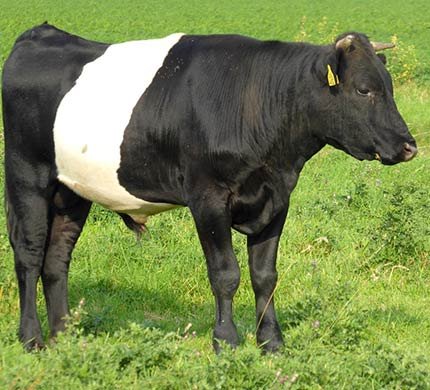Lakenvelder Cattle
- Temperature:40-70°F (4-21°C)
- Milk:20-30 liters per day
- Food:Green Fodder, Hay, Silage
- Pregnancy:Approximately 9 months
- Nationality:Netherlands

General Information
Lakenvelder cattle are a breed of dairy cattle that originated in the Netherlands, specifically in the region of Gelderland. They are easily recognizable by their striking black and white striped coat pattern, which gives them their name “Lakenvelder”, which means “tablecloth” in Dutch.
Lakenvelders are a medium-sized breed, with cows weighing around 600-700 kg (1,300-1,500 lb) and bulls weighing around 900 kg (2,000 lb). They are known for their docile temperament, making them easy to handle and milk.
In terms of milk production, Lakenvelders are considered a good dairy breed, with an average milk yield of around 5,500 kg (12,100 lb) per lactation. They are also known for the quality of their milk, which is high in protein and butterfat.
Where we find this cow to buy?
Lakenvelder cattle are a rare breed, and as such, they may not be widely available for purchase in all regions. However, there are several ways to find Lakenvelder cattle for sale:
01. Contact Lakenvelder breed associations or societies : In many countries, there are breed associations or societies dedicated to promoting and preserving Lakenvelder cattle. These organizations may have a list of breeders or farmers who have Lakenvelder cattle for sale.02. Check online classifieds and directories : There are many online classifieds and directories that list livestock for sale, including Lakenvelder cattle. Websites such as Craigslist, Livestock Of America, and Farmia may have listings for Lakenvelder cattle for sale.03. Attend livestock shows and auctions : Livestock shows and auctions can be a good place to find Lakenvelder cattle for sale. Breeders and farmers may bring their Lakenvelders to these events to showcase them and offer them for sale.
It’s important to note that because Lakenvelder cattle are a rare breed, they may be more expensive than other breeds of cattle. Additionally, it’s important to ensure that you have the appropriate facilities and resources to care for Lakenvelder cattle before making a purchase.

How to increase milk production in Lakenvelder Cattle
Lakenvelder is a breed of dairy cattle that originated in Germany and known for their high milk production. However, there are several steps you can take to increase their milk production further:
01
Providing Lakenvelder with a balanced diet is essential for milk production, including access to fresh, clean water, high-quality forage, and a balanced grain mix.
02
Maintaining proper hygiene during milking is essential for successful production.
03
Choosing the right bull for breeding can significantly impact the milk production of Lakenvelder. Select bulls with high milk production and other desirable traits.
04
Monitoring Lakenvelder’s milk production to identify issues and take corrective measures.
Medicine
Braford cattle may require medication at times to treat or prevent illnesses. The specific medicines used for Braford cattle will depend on the condition being treated or prevented. Here are some common medications that may be used for Braford cattle:
01
AntibioticsAntibiotics are used to treat bacterial infections in Braford cattle, such as pneumonia and mastitis.
02
DewormersDeworming medications treat internal parasites in cattle, improving health and milk production.
03
VaccinesVaccines are used to prevent infectious diseases in Braford cattle, such as BRSV, IBR, and brucellosis.
04
NSAIDsNSAIDs can be used to reduce inflammation in cattle with lameness or mastitis.
Pregnancy
Pregnant Lakenvelder cows require a diet that is rich in protein, energy, and minerals. High-quality hay, green fodder, silage, and concentrates should be provided in adequate quantities to meet their nutritional needs.
Pregnant cows should be monitored regularly for signs of illness, such as loss of appetite, lethargy, or abnormal behavior. Any health concerns should be promptly addressed by a qualified veterinarian.
Pregnant cows should be vaccinated against common diseases to protect their health and the fetus.
It’s important to ensure that pregnant cows have access to clean and fresh drinking water at all times.
Important!
It’s important to note that the specific management practices for pregnant Lakenvelder cattle may vary depending on individual factors such as age, weight, and health status. It’s recommended to consult with a qualified veterinarian or agricultural expert for advice and guidance on managing Lakenvelder cattle during pregnancy.
Food
Fresh green fodder, such as alfalfa, clover, and ryegrass, is a good source of protein, energy, and fiber.
High-quality hay, such as legume or grass hay, is a good source of fiber and nutrients.
Silage is made by fermenting chopped green forage, such as corn or grass, and is a good source of energy.
Concentrates such as grains, grains, and protein-rich supplements are a good source of energy and protein.
Facts
Lakenvelder cattle are a breed of dairy cattle that originated in the Netherlands. Here are some facts about them:
Lakenvelder cattle have a distinct black and white pattern, with a white body and black head and legs. They are medium-sized, with cows weighing around 550-660 kg (1200-1450 lbs) and bulls weighing around 900 kg (2000 lbs).
Lakenvelder cattle are considered a rare breed, with a small population both in their native Netherlands and around the world. The breed is listed as “vulnerable” on the Livestock Conservancy’s Conservation Priority List.
Lakenvelder cows are known for their high milk production, with an average of 5,500-6,000 kg (12,000-13,200 lbs) of milk per lactation. The milk has a high protein content, making it ideal for cheese production.
Lakenvelder cattle are known for their calm and docile temperament, which makes them easy to handle and work with.
The breed originated in the region of Twente in the eastern part of the Netherlands in the 19th century. They were developed as a dual-purpose breed for milk and beef production.
While the breed is rare, it can be found in other countries, including the United States, where there is a small population of Lakenvelder cattle.